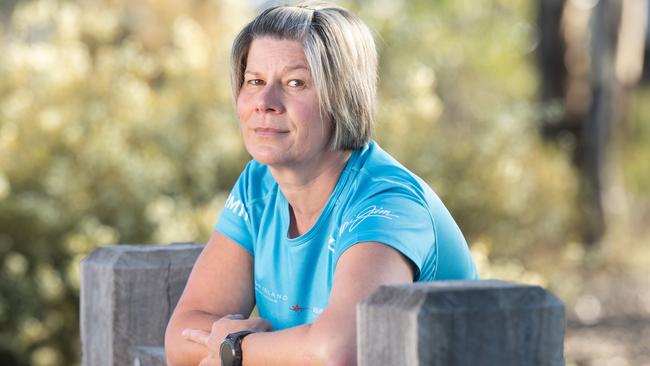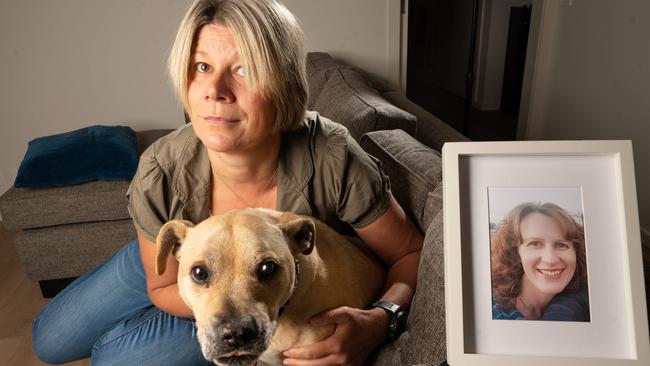‘No warning’ for silent killer fibromuscular dysplasia
Months after a rare blood vessel disorder took the life of her only sister, Karena Spencer was diagnosed with the same life-changing condition. Now she’s on a mission to save others.

Victoria
Don't miss out on the headlines from Victoria. Followed categories will be added to My News.
The unexpected death of Cristy Spencer shattered her family.
Much-loved and proudly community-minded, Cristy was only 44 when she suffered a catastrophic stroke in Melbourne two years ago.
Her sister Karena Spencer says in the days beforehand her only sibling was complaining of a headache — niggling more than concerning.
Ms Spencer said while Cristy lived in Melbourne close to expert specialist care and her stroke was identified early, the degree of injury was too extensive.
“My sister never had high blood pressure and she was petite,” Ms Spencer said. “There were no obvious signs or warning.”

While coping with her heartache came the body blow that the Bendigo intensive care nurse also had the same potentially fatal disease as her sister: fibromuscular dysplasia (FMD). This is a rare blood vessel disorder associated with hypertension, stroke and heart attack that is 10 times more likely in women than men.
Karena, now 44, says she used to live for endurance events and thrived on the physical challenges they presented. She even represented Australia at an Ironman 70.3 World Triathlon Championship event in South Africa in 2018.
“I was never a podium finisher,” she smiled.
That was before she was diagnosed with FMD, which she described as life-changing.
“Over the next six months I struggled to come to terms with my diagnosis,” Ms Spencer said. “I felt like a ticking time bomb. The only person I knew with the condition died.
“Unfortunately, Cristy did not know she had FMD, and we know now that having a proper diagnosis greatly reduces risks. Her death has given me the opportunity to live, which in itself has caused a degree of survivor guilt.

“I have often thought why her, why not me. Now I talk a lot about FMD and I am trying to educate others. Awareness in Australia is minimal.”
The usually very private Ms Spencer is now putting herself into the spotlight to help raise awareness of FMD with the support of The Alfred in Melbourne and the Victor Chang Cardiac Research Institute in Sydney.
Ms Spencer said she first heard of the disorder when a doctor briefly mentioned it as the cause of Cristy’s initial stroke.
She went in search of answers but found it difficult to find reliable and consistent information until she sought advice from Jason Kovacic, the Executive Director of the Victor Chang Cardiac Research Institute in Sydney.
While Professor Kovacic sees FMD patients in Sydney, he put her in touch with Associate Professor Scott Wilson who runs one of Australia’s few other FMD specialist clinics at The Alfred in Melbourne. The clinic is part of The Alfred’s women’s heart clinic.
Associate Professor Wilson says FMD is typically seen in women under the age of 45.
“It can be managed, not cured,” he said. “Treatment is around risk factor mitigation; reducing the risk in patients with known abnormalities in their arteries.”
Associate Professor Wilson says it is a disease of medium sized blood vessels, typically to the kidney, heart and brain but many areas can be involved – and most often found in radiographic imaging of an artery that appears “irregular” and “lumpy” like a “string of beads” rather than a smooth structure.

“If Karena had not reached out to me, it could have turned out differently,” Professor Kovacic said.
“It is concerning that there are likely to be other women who remain undiagnosed and are unaware that they may have FMD. We need to ensure that clinicians and the community are more aware of this disease and its symptoms.”
Professor Kovacic said major inroads had been made into understanding what causes FMD and that they were honing in on what are believed to be some of the key genes driving this disease.
“Although we still have a long way to go, this is bringing us closer to treatments and genetic diagnoses,” he said. “But until then, we still have a lot of work to do to raise awareness about FMD and to manage those who are known to have the disease.”
FMD at a glance
• Research studies led by Prof Kovacic and others have shown that genetics plays a key role in causing FMD
• FMD is thought to affect up to one in 20 women but most will have no or only mild symptoms
• High blood pressure is the most common complication
• It is often identified in previously fit young women who suffer a type of heart attack called Spontaneous Coronary Artery Dissection or “SCAD”
• The only way to diagnose it at present is with arterial imaging, ideally either CT or MRI




